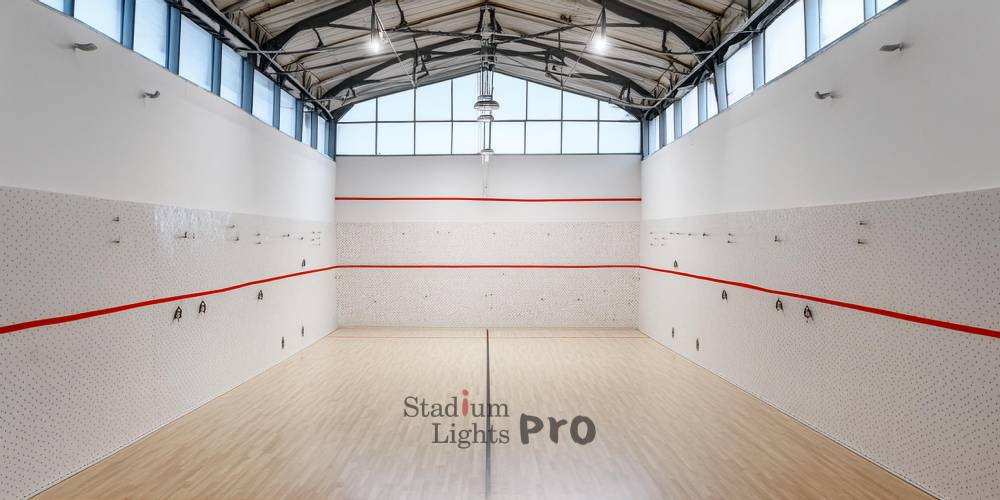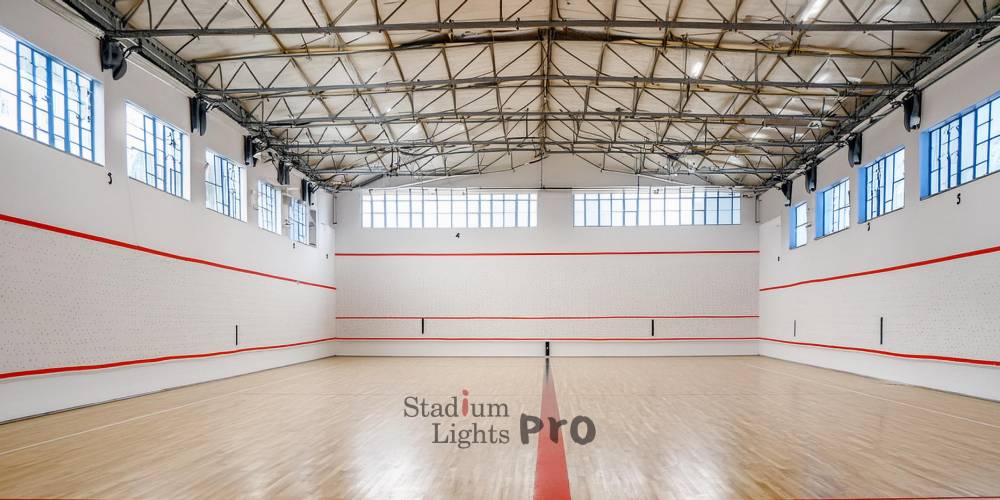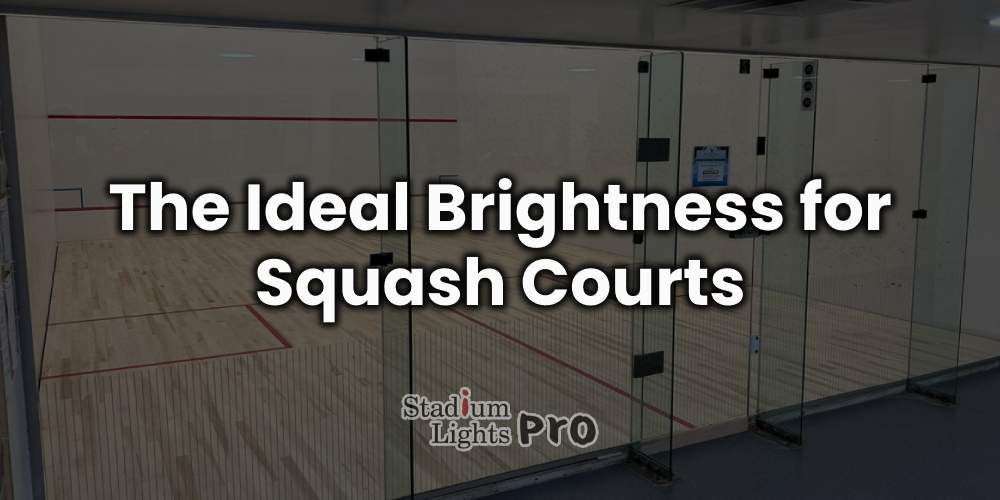With the advent of LED lighting technology, there are now more options than ever to achieve the ideal brightness for squash courts. This article explores the importance of appropriate lighting in squash courts, delves into the benefits of LED lighting, and provides guidelines on how to achieve the optimal lighting conditions.
Table of Contents
ToggleThe Importance of Proper Lighting in Squash Courts
Enhancing Player Performance
Lighting directly impacts player performance in squash. Insufficient or uneven lighting can cause visual discomfort and strain, leading to decreased accuracy and slower reaction times. Proper lighting, on the other hand, ensures that players can see the ball clearly, judge its speed and trajectory accurately, and respond quickly to their opponent’s moves. This is particularly important in squash, where the ball travels at high speeds and players must make split-second decisions.
Ensuring Player Safety
Safety is paramount in any sport, and squash is no different. Poor lighting can increase the risk of accidents and injuries, as players might misjudge the distance to the walls or fail to see the ball coming towards them. Bright, uniform lighting helps prevent such mishaps by providing clear visibility of the entire court, including the walls, floor, and ball.
Creating a Professional Environment
For tournaments and competitive play, the quality of lighting can make a significant difference. High-quality, consistent lighting creates a professional atmosphere that is essential for both players and spectators. It ensures that all participants compete on an equal footing, without any lighting-related advantages or disadvantages.

Benefits of LED Lighting
The advent of LED lighting has catalyzed a transformative revolution in the illumination of indoor sports facilities, eclipsing the limitations of traditional lighting methods with its myriad advantages. Unlike its predecessors, LED lights offer unparalleled energy efficiency, significantly reducing operational costs and aligning with the imperative for sustainable practices. With an impressive lifespan that outlasts conventional lighting sources, LED fixtures minimize maintenance efforts while ensuring prolonged periods of uninterrupted illumination, enhancing the playing experience for athletes and spectators alike. Moreover, LED technology delivers bright, uniform light that enhances visibility across the entire sports facility, while its versatility allows for dynamic adjustments to lighting levels and effects, creating immersive environments tailored to the unique requirements of different sports and events. In essence, LED lighting sets a new standard for excellence in sports illumination, promising a future defined by efficiency, adaptability, and unparalleled quality of light.
Energy Efficiency
LED lights have garnered widespread acclaim for their exceptional energy efficiency, a characteristic that sets them apart from traditional lighting alternatives such as incandescent or fluorescent bulbs. This heightened efficiency stems from the unique way in which LED technology operates, converting a greater proportion of electrical energy into visible light while minimizing the dissipation of heat. Unlike incandescent bulbs, which generate light by heating a filament until it emits photons, or fluorescent bulbs, which rely on the excitation of gases to produce light, LEDs produce light through a process known as electroluminescence. This process involves the movement of electrons within a semiconductor material, which releases energy in the form of photons, resulting in the emission of light. As a result of this fundamentally different mechanism, LED lights consume significantly less electricity to produce the same level of illumination as their traditional counterparts. This translates into tangible cost savings for indoor sports facilities over time, as the reduced energy consumption of LED lights leads to lower utility bills and decreased operating expenses. Moreover, the energy efficiency of LEDs contributes to a more sustainable approach to lighting, aligning with the growing emphasis on environmental conservation and reducing the carbon footprint of sports facilities.
Longevity
LEDs boast an exceptionally long lifespan compared to traditional lighting sources like incandescent or fluorescent bulbs, a characteristic that has profound implications for indoor sports facilities. This extended longevity is primarily attributed to the inherent durability and reliability of LED technology, which is engineered to withstand the rigors of continuous operation over prolonged periods. Unlike incandescent bulbs, which are prone to filament breakage and degradation over time, or fluorescent bulbs, which are susceptible to issues such as cathode wear and phosphor degradation, LEDs are solid-state devices with no moving parts, making them inherently more robust and resilient. As a result, LED fixtures can endure tens of thousands of hours of use without experiencing significant degradation in performance or luminosity, far outlasting their traditional counterparts. This prolonged lifespan translates into tangible benefits for sports facility operators, as it reduces the frequency of replacements and maintenance interventions, thereby minimizing downtime and associated costs. Moreover, the longevity of LED lights contributes to a more sustainable approach to lighting, as it reduces the volume of waste generated from discarded bulbs and supports efforts to conserve resources and reduce environmental impact. Overall, the extended lifespan of LEDs represents a significant advantage for indoor sports facilities, providing a reliable and cost-effective lighting solution that delivers consistent performance over the long term.
Brightness and Quality
LEDs are renowned for their ability to deliver bright and uniform illumination, setting a new standard for lighting quality in indoor sports facilities. Unlike traditional lighting sources, which often produce uneven illumination with noticeable variations in brightness and intensity, LEDs emit light in a highly controlled and directional manner, resulting in consistent and uniform lighting conditions across the entire sports facility. This uniformity is achieved through the precise engineering of LED fixtures, which are designed to distribute light evenly and efficiently, minimizing the occurrence of shadows, hotspots, and dark spots. Moreover, LEDs offer exceptional color consistency, ensuring that the illumination remains true and vibrant regardless of the viewing angle or distance. This uniformity not only enhances visibility for athletes and spectators but also contributes to a more immersive and engaging environment, elevating the overall experience of sports events and competitions. Furthermore, LEDs exhibit minimal flicker, a common issue associated with traditional lighting sources, which can cause discomfort and visual fatigue, particularly during high-intensity activities such as sports. By providing stable and flicker-free illumination, LEDs ensure optimal comfort and safety for players, allowing them to focus on their performance without distractions. In essence, the bright and uniform illumination offered by LEDs represents a significant advancement in sports lighting technology, enhancing the quality and consistency of lighting conditions in indoor sports facilities.
Instant On/Off
One of the remarkable features of LED lighting is its instantaneous response to control commands, allowing it to turn on and off without any delay or warm-up time. This characteristic stands in stark contrast to certain traditional lighting sources, such as fluorescent bulbs, which typically require a brief warm-up period before reaching full brightness. LED lights, on the other hand, achieve full illumination instantly upon activation, providing immediate and reliable lighting whenever needed. This rapid response time is particularly advantageous in sports facilities, where quick adjustments to lighting levels may be necessary to accommodate changing activity schedules or unexpected events. Whether it’s the start of a game, a practice session, or a sudden power outage, LED lights ensure that the sports facility remains well-lit and operational without any waiting period or downtime. This instant on/off capability not only enhances the convenience and flexibility of lighting control but also contributes to a seamless and uninterrupted experience for athletes and spectators alike. Additionally, the absence of warm-up time reduces energy wastage and improves overall energy efficiency, further solidifying LEDs’ position as the preferred choice for modern sports lighting applications.
Eco-Friendly
LEDs represent a significant leap forward in environmental sustainability compared to traditional lighting technologies, primarily due to their composition and recyclability. Unlike some traditional lights, such as fluorescent bulbs, which contain hazardous materials like mercury, LEDs are entirely free from such harmful substances. This absence of mercury not only eliminates the risk of environmental contamination in the event of breakage or disposal but also mitigates health hazards for individuals involved in handling or installing the lighting fixtures. Additionally, LEDs are fully recyclable, meaning that they can be disassembled and their components repurposed or reused at the end of their lifespan. This recyclability not only reduces the environmental impact of discarded lighting fixtures but also conserves valuable resources by minimizing the need for raw materials in manufacturing new products. As a result, LEDs represent a sustainable and eco-friendly choice for indoor sports facilities, aligning with global efforts to reduce waste, minimize pollution, and promote environmental stewardship. By opting for LED lighting, sports facility operators can demonstrate their commitment to sustainability while enjoying the numerous performance and cost-saving benefits that LEDs offer.

The Role of LED Lighting in Squash Courts
The unique advantages offered by LED lighting make it an ideal choice for illuminating squash courts, catering to the specific needs and requirements of both facility managers and athletes. Firstly, the unparalleled energy efficiency and longevity of LEDs align perfectly with the cost-conscious priorities of facility managers. LED lights consume significantly less energy than traditional lighting sources, resulting in substantial cost savings on utility bills over the long term. Additionally, their extended lifespan minimizes the frequency of replacements and maintenance interventions, reducing operational expenses and maximizing the return on investment for sports facility operators. Moreover, the brightness and quality of illumination provided by LEDs ensure optimal playing conditions for squash athletes. With their bright and uniform light output, LEDs enhance visibility across the entire court, allowing players to track the ball accurately and make precise shots with confidence. This improved visibility translates into enhanced performance and enjoyment for athletes, contributing to a more competitive and engaging playing experience. Furthermore, the instant on/off feature of LED lighting is particularly advantageous for squash courts that may not be in use continuously. Unlike traditional lighting sources that require warm-up time or suffer from delays in activation, LEDs provide immediate illumination at the flick of a switch, ensuring that the court is ready for play whenever needed. This rapid response time enhances the flexibility and usability of squash facilities, accommodating fluctuating schedules and unexpected changes in activity without any downtime or inconvenience. In essence, LED lighting emerges as the optimal lighting solution for squash courts, delivering a perfect blend of energy efficiency, longevity, brightness, and responsiveness that caters to the diverse needs of both facility managers and athletes alike.
Achieving the Ideal Brightness: Guidelines and Standards
Recommended Light Levels
The ideal brightness for squash courts is typically measured in lux, which is a unit of illumination. According to industry standards, squash courts should have a lighting level of around 500-750 lux at the floor level and 750-1000 lux at the eye level of the players. These levels ensure that the court is brightly lit, with sufficient contrast to clearly see the ball and walls.
Uniformity of Lighting
Uniform lighting is crucial to avoid shadows and glare, which can distract players and affect their performance. The lighting should be evenly distributed across the entire court, with minimal variation in intensity. This can be achieved through careful planning of the lighting layout and the use of high-quality LED fixtures designed to provide consistent illumination.
Color Temperature and CRI
The color temperature of the lighting also plays a significant role in player comfort and performance. A color temperature of around 4000-5000 Kelvin is generally recommended for squash courts, as it provides a bright, neutral light that closely resembles daylight. Additionally, the Color Rendering Index (CRI) of the lights should be 80 or higher, ensuring that colors appear natural and vibrant, which helps players see the ball and court markings clearly.
Planning and Design in Squash Courts
Assessing the Space
The first step is to thoroughly assess the dimensions of the court, including its length, width, and height. Additionally, the height of the ceiling should be taken into account, as it will impact the distribution and intensity of light. It is also important to evaluate the existing lighting infrastructure, including the type and placement of existing fixtures, to determine if any upgrades or modifications are necessary.
Selecting the Right Fixtures
Choosing the appropriate LED fixtures is crucial to ensure optimal lighting performance. The selected fixtures should meet the recommended standards for brightness, uniformity, and color temperature. High-quality fixtures with adjustable features can provide flexibility in achieving the desired lighting levels and effects.
Layout Design
The layout of the fixtures plays a critical role in achieving uniform lighting across the entire court. Careful planning is required to ensure that the fixtures are strategically positioned to minimize shadows and glare. A well-designed layout will result in even distribution of light, enhancing visibility and reducing visual fatigue for players.
Dimming and Control Systems
Incorporating dimming and control systems allows for further customization of lighting levels based on the specific needs of the game or event. These systems enable adjustments to be made easily and efficiently, providing greater flexibility and versatility in managing the lighting environment.
Installation and Maintenance
Once the planning and design phase is complete, the installation of LED lighting should be carried out by qualified professionals to ensure safety and optimal performance. Proper installation involves mounting the fixtures at the appropriate height and angles to achieve the desired lighting effects. Additionally, regular maintenance is essential to ensure the longevity and efficiency of the lighting system. Periodic checks should be conducted to inspect for any signs of wear or damage, and the fixtures should be cleaned as needed to maintain maximum brightness and efficiency. By adhering to these guidelines, squash courts can achieve the ideal lighting conditions necessary for optimal performance and player experience.
Conclusion
LED lighting technology has emerged as a game-changer in this regard, offering a multitude of benefits over traditional lighting methods. LED lights provide energy-efficient, long-lasting illumination that enhances visibility and minimizes visual strain for players. Moreover, their instant on/off feature, eco-friendliness, and adaptability make them the ideal choice for squash courts. By following guidelines for proper planning, design, and implementation of LED lighting, squash facilities can achieve the ideal brightness levels necessary for optimal gameplay. Overall, LED lighting represents a significant advancement in sports illumination, promising a brighter, more sustainable future for indoor sports facilities.

